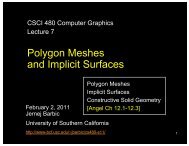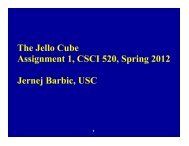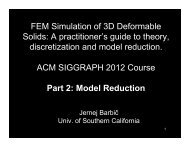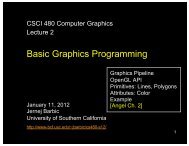Vega FEM Library (v1.1) User's Manual - University of Southern ...
Vega FEM Library (v1.1) User's Manual - University of Southern ...
Vega FEM Library (v1.1) User's Manual - University of Southern ...
You also want an ePaper? Increase the reach of your titles
YUMPU automatically turns print PDFs into web optimized ePapers that Google loves.
2.10 isotropicHyperelastic<strong>FEM</strong><br />
Provides classes to calculate the energy, internal forces and stiffness matrices <strong>of</strong> a variety <strong>of</strong> invertible material<br />
methods.<br />
class IsotropicHyperelastic<strong>FEM</strong> Provides an implementation <strong>of</strong> the invertible <strong>FEM</strong> method presented<br />
in [ITF04]. Also computes the tangent stiffness matrix as presented in [TSIF05]. Supports isotropic hyperelastic<br />
materials with energy defined in terms <strong>of</strong> the three invariants I, II, III. A few such example materials<br />
are provided, and the user can define her own custom materials simply by deriving from IsotropicMaterial.<br />
IsotropicHyperelastic<strong>FEM</strong>(TetMesh * tetMesh,<br />
IsotropicMaterial *<br />
isotropicMaterial, int numThreads=1,<br />
double principalStretchThreshold=-DBL MAX,<br />
bool addGravity=false, double g=9.81)<br />
Reads the mesh tetMesh, pre-computes the area weighted vertex normals, the inverse <strong>of</strong> the Dm (as<br />
in [ITF04]), and the derivative <strong>of</strong> the deformation gradient with respect to the vertex displacements. Parameter<br />
principalStretchThreshold specifies a minimum value for the principal stretches <strong>of</strong> element deformation<br />
gradients; stretches below this value will be clamped to it for force and stiffness calculations.<br />
The isotropicMaterial must be pre-created: you can use one <strong>of</strong> our provided classes, or derive from the<br />
IsotropicMaterial to create your own custom isotropic hyperelastic materials.<br />
double ComputeEnergy(double * vertexDisplacements)<br />
Given the array vertexDisplacements <strong>of</strong> vertex displacements from rest position, returns the non-linear<br />
elastic strain energy <strong>of</strong> the mesh. The energy is calculated based upon the principal stretches <strong>of</strong> the SVDdiagonalized<br />
deformation gradients <strong>of</strong> the individual mesh elements.<br />
void ComputeForces(double * vertexDisplacements, double * internalForces)<br />
Given the array vertexDisplacements <strong>of</strong> vertex displacements, writes the resulting vertex forces to<br />
the pre-allocated array internalForces. Forces are calculated from the principal stretches <strong>of</strong> the SVDdiagonalized<br />
deformation gradients <strong>of</strong> the individual mesh elements.<br />
void GetStiffnessMatrixTopology(SparseMatrix ** stiffnessMatrixTopology)<br />
Allocates (new) a SparseMatrix with the correct pattern <strong>of</strong> non-zero entries to hold a stiffness matrix<br />
for this material, and writes the matrix pointer to *tangentStiffnessMatrix.<br />
void GetTangentStiffnessMatrix(double * u, SparseMatrix * tangentStiffnessMatrix)<br />
Writes the stiffness matrix arising from vertex displacements u to the pre-allocated tangentStiffnessMatrix.<br />
The stiffness matrix is calculated based upon the principal stretches and rotation matrices from the SVD<br />
diagonalization <strong>of</strong> the deformation gradient <strong>of</strong> each element.<br />
class IsotropicMaterial Serves as a base class for isotropic hyperelastic materials which define energy is<br />
defined in terms <strong>of</strong> the three invariants I, II, III. This represents the material <strong>of</strong> a single element (tet or<br />
cube).<br />
virtual double ComputeEnergy(int elementIndex, double * invariants) = 0<br />
Returns the energy <strong>of</strong> the element given the three invariants invariants[0], invariants[1], and<br />
invariants[2]. The integer variable elementIndex makes it possible to make the material properties vary<br />
from element to element (heterogeneous material properties).<br />
virtual void ComputeEnergyGradient(int elementIndex,<br />
double * invariants, double * gradient) = 0<br />
Given the three invariants invariants[0],invariants[1],invariants[2] computes the derivative <strong>of</strong><br />
the energy with respect to the invariants and writes the result to gradient[0],gradient[1],gradient[2].<br />
16
















